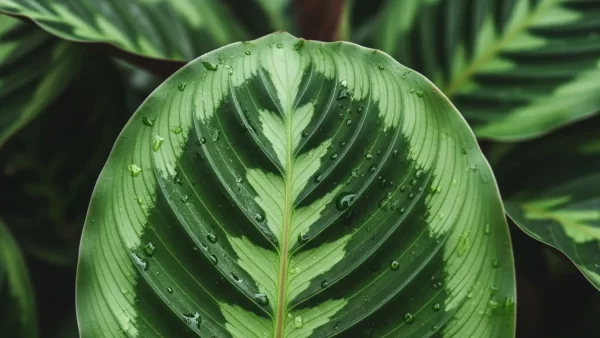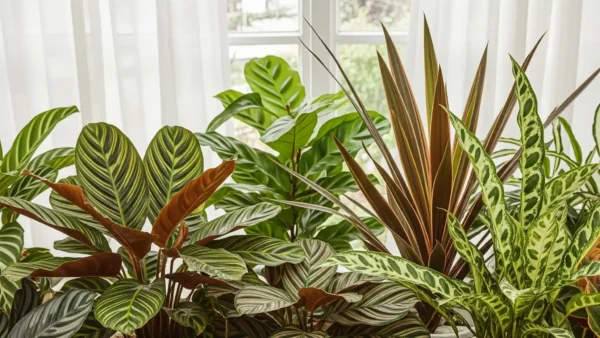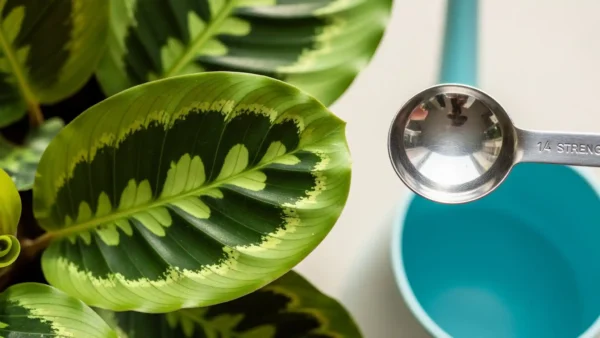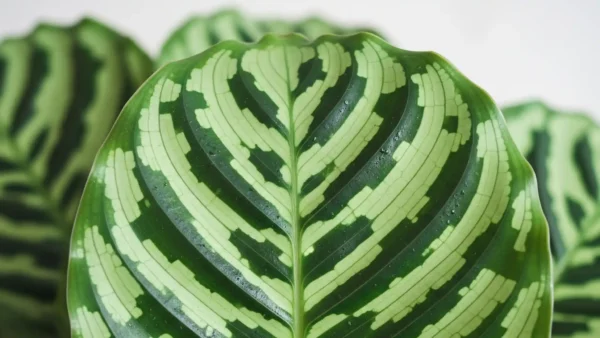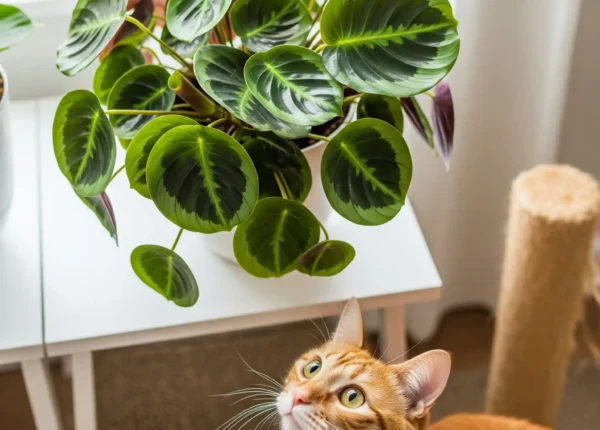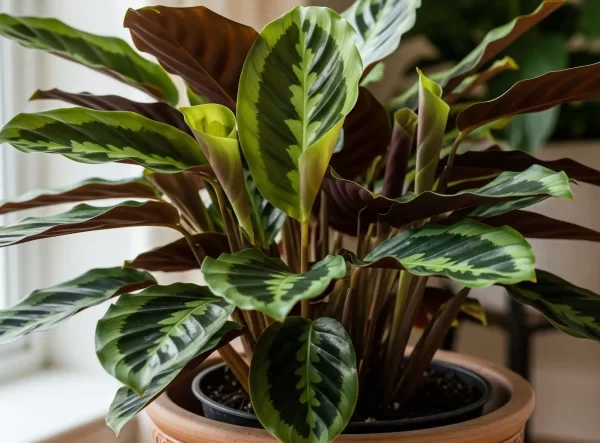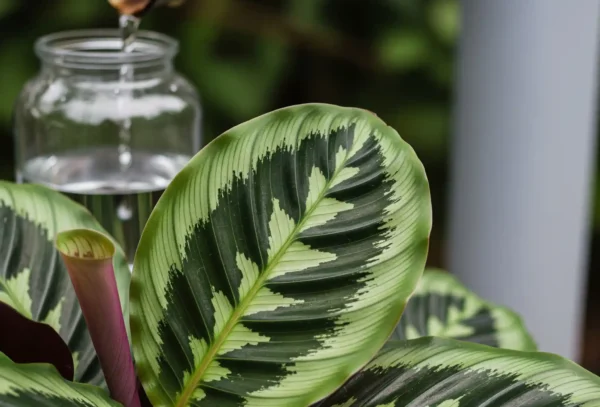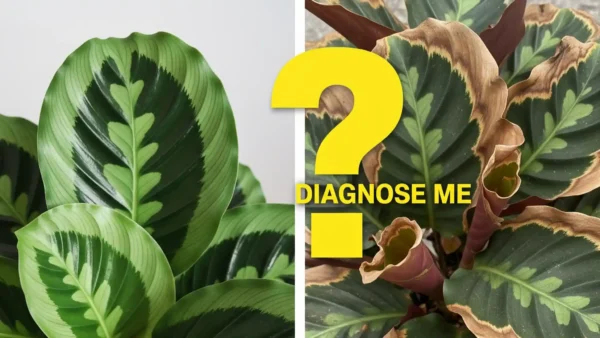Can Calathea Grow in Water? The Scientific Truth and a Guide to Getting Started
TL;DR (Too Long; Didn’t Read)
- Short Answer: Yes, you can root a Calathea division in water for a short time. This is an excellent technique to grow a new plant.
- Long-Term Answer: No, a Calathea cannot live in a simple vase of plain water for a long time. It will eventually perish since its roots are rotting and it isn’t getting enough nutrients.
- The Solution for Long-Term Growth: You need to utilize a soilless approach called semi-hydroponics, which usually involves using LECA and a particular hydroponic nutrition solution.
- Key to Success: To be successful, you need to know that water roots are not the same as soil roots. The change from water to soil is a very important time that needs to be carefully managed to avoid shock and damage.
The Allure of Soilless Calathea
The subject that both novice and veteran plant owners are interested in is: can the beautiful and notoriously picky Calathea really flourish in water? You might have seen gorgeous pictures online of a prayer plant’s colorful leaves rising gracefully from a transparent vase and thought, “Could I get that same clean, simple look?”
It’s not as simple as a yes or no answer. It’s far more complicated and interesting. Let’s get into the science, the techniques, and the keys to success.
The Quick Answer vs. The True Answer
Before we get into the interesting biology underlying it, let’s get the immediate question out of the way.
- The Short Answer: Yes, a Calathea division can live and establish new roots in water for a short time. This method is called water propagation, and it’s a great approach to grow new plants.
- The True Answer: The truth is that a Calathea cannot live for a long time in a basic vase with ordinary water. Eventually, it will die from root rot and a lack of nutrients. You need to use a special soilless approach called semi-hydroponics to permanently cultivate a Calathea in water.
This guide will provide you the information you need to do well at both. We’ll talk about how to build up a healthy, long-term hydroponic Calathea and how to temporarily propagate water.
I’ve seen a lot of gorgeous pictures of a Calathea in a clear vase online, but you can’t see how healthy the same plant is a few months later. We’ll talk about the appropriate technique to do this such that it works for both short-term growth and long-term health in a hydroponic system.
The Science: What Makes Water Roots and Soil Roots Different
You need to know one basic thing before you can comprehend why a Calathea can’t just remain in a vase forever: roots that grow in water are different from roots that develop in soil.
- Soil roots are strong, thick, and durable. Their main duty is to hold the plant in place and push through a thick, rough material to find water and nutrients. They have a thick coating of protection on them and small root hairs that help them take up nutrients that are chemically bonded to soil particles. They “breathe” in oxygen from the air pockets in soil that has good air flow.
- Water roots are thin, fragile, and sometimes bright white or feathery. Their outer shell is significantly thinner, and they are made to have as much surface area as possible so that they may collect dissolved oxygen directly from the water. They are weak and not made to deal with the dense, abrasive nature of soil.
| Feature | Soil Roots | Water Roots |
|---|---|---|
| Structure | Strong, thick, and tough | Fine, soft, and feather-like |
| Function | Anchor plant, soak up water from the ground | Take up dissolved nutrients and oxygen from water |
| Oxygen Source | Air pockets in the ground | Oxygen that is dissolved in water |
| Durability | High | Low (easy to break) |
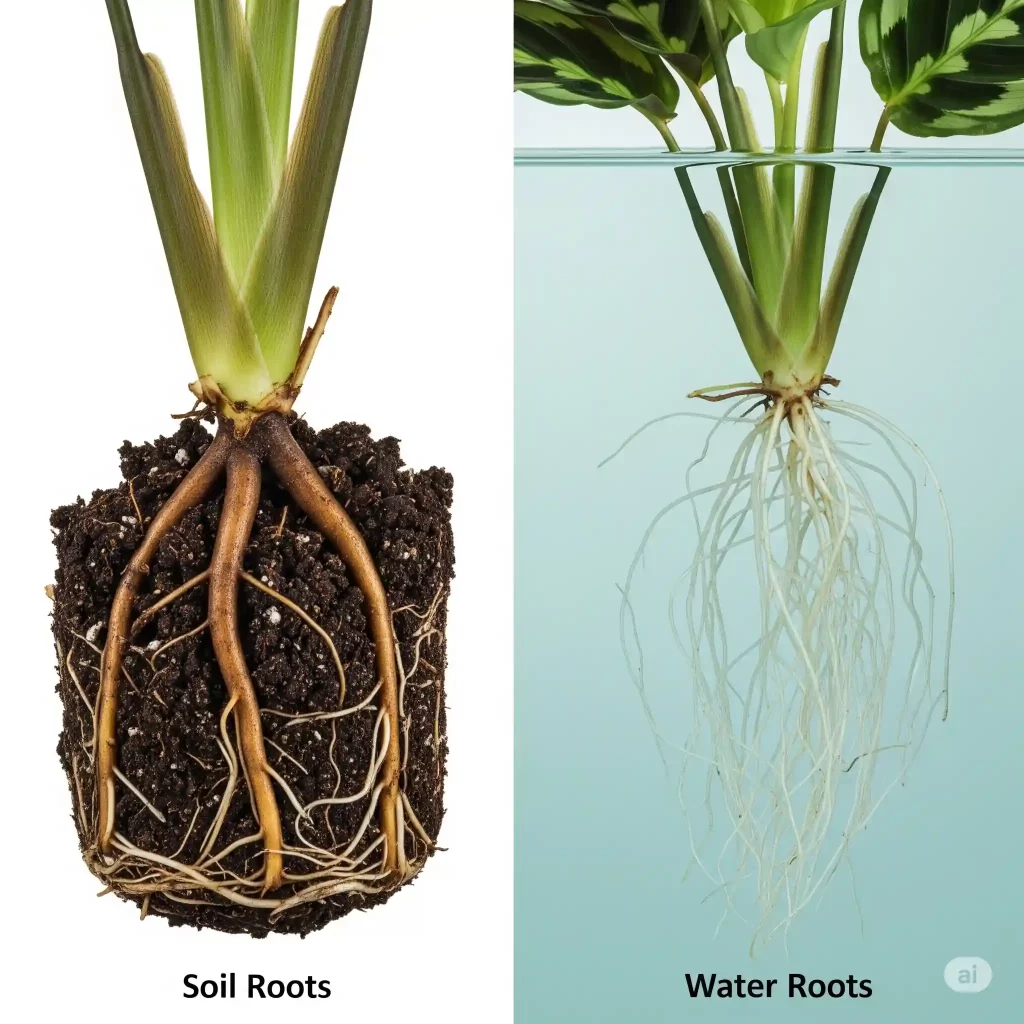
This disparity is what causes the transition problem. When you put a plant that has grown in soil into water, its tough soil roots can’t get oxygen from the water, so they start to drown, which causes them to rot. On the other hand, when you move a plant that grows in water into soil, its delicate water roots can quickly get hurt and rot before they have a chance to get used to the new, harsher environment. To be successful, you need to comprehend and handle this important change.
Method 1: How to Propagate Calathea Divisions in Water (Short-Term)
This is the best approach to grow a fresh Calathea plant that you may eventually put in soil. It’s a wonderful process that enables you see the marvel of roots growing up close.
Step 1: Pick a Candidate and Divide Them Up
You can’t grow a Calathea from a simple leaf or stem cutting like you can with a Pothos. These plants have rhizomes, thus you have to grow them from a piece of the main root structure.
Pick a mother plant that is healthy, grown up, and growing. Carefully take it out of its pot and seek for a natural clump or branch that has at least 2–3 healthy leaves and a small yet established root system. Make a clean, sharp cut using a knife to detach this division from the parent plant.
Which types work the best? In my experience, the Rattlesnake Calathea (C. lancifolia) and the Network Calathea (C. musaica) are two of the best types of plants for water propagation since they have stronger rhizomes. They can handle the shock better. Until you have more experience, I would stay away from trying this with more picky, thin-rooted types like the White Fusion Calathea (C. ‘White Fusion’).
Step 2: Get the Division and the Water Ready
This step is very important to stop rot. You need to carefully yet completely wash all the dirt from the roots of your new division. The anaerobic bacteria that make the roots mushy will eat any dead organic debris that is still on them.
I use a soft-bristled toothbrush for kids to gently scrape the last traces of dirt off the rhizome and roots. Being clean is really important. Put the divide in a transparent glass container after it has been cleaned so you can readily see how the roots are growing. Fill it with pure water, such distilled, rainfall, or reverse osmosis water. This is important to keep the delicate, newly exposed roots from getting chemical burns.
Step 3: Take Care of and Maintain the Water
Put your new plant in a place where it gets bright, indirect light. The most crucial requirement is that you have to replace the water every two to three days.
This isn’t only to keep things “fresh.” You are performing two very important things:
- Adding more dissolved oxygen: The roots are always using up the dissolved oxygen in the water. There isn’t much oxygen in stagnant water, therefore it causes asphyxia and decay.
- Taking Out Trash: The roots release garbage that, if not cleaned up, will make the water dirty and help harmful bacteria develop.
Step 4: Moving to the Ground
You should start to see new, bright white water roots appear and flourish within a few weeks. When these new roots are 1 to 2 inches long and have started to grow smaller, secondary branches, it’s time to move them to soil.
Put your newly rooted Calathea in a tiny container with a Calathea soil mix that is very airy and drains well. Now you have to handle the important time of acclimatization. The new water roots are going to be shocked. For the first two to three weeks, keep the soil a little wetter than you would for a plant that has been there for a while (but not too wet). To help the roots that are having trouble, keep the humidity very high by putting a clear plastic bag over the pot to make a mini-greenhouse. After a week, start opening the bag for a few hours a day. Gradually increase the time to “wean” the plant off the extra humidity and get it used to the atmosphere in your home.
Method 2: Growing Calathea in a Hydroponic System (Long-Term)
You can’t just use normal water if you want a plant in a vase to look good for a long time. You have to set up a good semi-hydroponic system.
Why Plain Water Doesn’t Work: A Slow Starvation Cascade
A plant that lives in simple water is running out of time. It is slowly dying of hunger. Here is the chain of failures you will see over the next few months:
- Nitrogen Deficiency: The plant can’t make chlorophyll without nitrogen. The plant will cease growing new leaves and start eating its old ones, which will render them a sickly yellow color.
- Potassium Deficiency: Without enough potassium, the plant’s cells become weaker, making it limp, feeble, and very likely to get sick.
- Calcium and Magnesium Deficiency: If you don’t have these important minerals, any new growth that does happen will be little, weak, and misshapen.
The Answer: LECA with Semi-Hydroponics
To be successful with soilless gardening for a long time, you need to use a sterile growing media and a fertilizer solution. LECA (Lightweight Expanded Clay Aggregate) is the most popular and useful medium.
LECA balls are clay pebbles with holes in them that make them the proper balance. They use capillary action to draw water up to the roots, which keeps them constantly hydrated. The big spaces between the pebbles also let air flow freely, which gives the roots the oxygen they need to stay healthy.
LECA is like a high-tech, long-lasting residential complex for your roots. It gives soil the right amount of water and support, which is great for a plant like Calathea. It’s the key to getting that clean, soil-free look without hurting the plant.
The Nutrient Solution and pH: Things You Can’t Change
You can’t use regular soil fertilizer to feed your plant in LECA. You need to utilize a full hydroponic fertilizer solution that has all 13 of the most important macro- and micronutrients. Some well-known brands are General Hydroponics Flora Series and Dyna-Gro Foliage-Pro.
The pH of your water is also very essential. If the pH is too low, nutrients can be in the water but not available to the plant, which means it can’t absorb them. To keep your nutrition solution in the right range of 5.5 to 6.5, you should utilize a simple pH testing kit.
Common Mistakes
Let’s get rid of some bad advice you might hear:
- Myth: If you dilute soil fertilizer, you can use it in water.
- Reality: Soil fertilizers are missing a lot of the micronutrients that people think are in the soil. You will still be missing something if you use them. They also include salts in them that can quickly kill roots in a hydroponic environment.
- Myth: Algae growing on the glass is a positive thing.
- Reality: In fact, algae isn’t dangerous on its own, but it does compete with your plant’s roots for nutrients and oxygen. It means that the water is getting too much light. To stop it from growing, it’s better to clean it off and think about using an opaque vase.
What to Do When Things Go Wrong: Troubleshooting
| Problem | Cause | Solution |
|---|---|---|
| Roots are becoming slimy | This is a bacterial biofilm, the first sign of root rot. | Take the plant out right away, rinse the roots gently under lukewarm water, clean the vase well with soap and water, and then fill it with new, clean water. |
| A leaf turned yellow and died right after being placed in water | This is normal transplant shock. The plant is sacrificing an older leaf to focus energy on growing new, adaptive water roots. | Cut off the dying leaf and be patient. |
| No new roots are forming after 3+ weeks | The division might not be viable, or the water might be too cold. | Move the vessel to a warmer spot with bright, indirect light. You could also try adding a drop of liquid rooting hormone to the water to stimulate growth. |
| A white crust is forming on the top LECA balls | This is mineral salt buildup from the nutrient solution evaporating. | Once a month, flush the pot by running plain, pH-balanced water through it for a few minutes to wash away the excess salts. |
Conclusion: Water is a Tool, Not a Home
Is it possible for a Calathea to grow in water? You now know everything there is to know. Water is a great short-term tool for propagation since it lets you see the magic of root growth up close. But a vase of water is not a good long-term home.
Now that you know this, you may confidently choose the best way to reach your goal: a short stay in water to grow a new plant for soil, or a long-term, healthy home in a good semi-hydroponic system. You’ve gone from asking a basic query to getting into the world of expert plant care.
Frequently Asked Questions (FAQ)
Can I merely place a cutting of a Calathea leaf or stem in water?
No. This is a really important aspect. Calatheas are rhizomatous plants, which means they don’t have the nodes on their stems that plants like Pothos use to make roots. The propagation must come from a part of the rhizome that already has roots. A leaf will just decay.
How long can a Calathea division truly stay alive in ordinary water?
It can live for a few months, but it won’t do well. After two to three months, the plant will show signs of nutrient deficiency, such as pale or yellowing leaves. As the plant gets weaker, the chance of unexpected root rot goes up a lot.
Does putting in an air stone help?
Yes, a lot. Putting an air stone from an aquarium pump in your water vessel can greatly raise the amount of oxygen that is already in the water. This speeds up root growth and makes it much less likely that anaerobic root rot will happen in both propagation and hydroponic systems.
Is it okay to put rooting hormone like Clonex in the water?
Yes. A small amount of liquid or gel rooting hormone will help roots grow faster, but be careful not to apply too much, as it might make the water dirty. A single drop is frequently all you need.
Does semi-hydroponics take more or less work than soil?
There is a trade-off. It usually needs less “watering” (you just fill up the reservoir), it gets rid of pests that live in the soil, like fungus gnats, and it looks cleaner. But it does need the initial setup expense and the habit of mixing nutrients and cleansing the system every so often.
Sources
- Micropropagation and Soilless Cultivation of Calathea
- Senevirathna, A. M. W. K., et al. (2014). Micropropagation of an Exotic Ornamental Plant, Calathea crotalifera, for Production of High Quality Plantlets. The Scientific World Journal, 2014, 457092. http://downloads.hindawi.com/journals/tswj/2014/457092.pdf
- Demonstrates successful Calathea propagation and acclimatization in soilless media, supporting the use of water and semi-hydroponic systems for short-term and long-term growth1.
- Senevirathna, A. M. W. K., et al. (2014). Micropropagation of an Exotic Ornamental Plant, Calathea crotalifera, for Production of High Quality Plantlets. The Scientific World Journal, 2014, 457092. http://downloads.hindawi.com/journals/tswj/2014/457092.pdf
- Water Requirements and Root Health in Calathea
- Chen, Y., et al. (2018). Quantification of Daily Water Requirements of Container-Grown Calathea and Stromanthe Produced in a Shaded Greenhouse. Water, 10(9), 1194. https://www.mdpi.com/2073-4441/10/9/1194/pdf?version=1536140484
- Provides data on Calathea water needs and highlights the importance of water quality and oxygenation for healthy root development2.
- Chen, Y., et al. (2018). Quantification of Daily Water Requirements of Container-Grown Calathea and Stromanthe Produced in a Shaded Greenhouse. Water, 10(9), 1194. https://www.mdpi.com/2073-4441/10/9/1194/pdf?version=1536140484
- Root Physiology: Water Roots vs. Soil Roots
- van Os, E. A., et al. (2017). Maximum Plant Uptakes for Water, Nutrients, and Oxygen Are Not Always Met by Irrigation Rate and Distribution in Water-based Cultivation Systems. Frontiers in Plant Science, 8, 562. https://www.frontiersin.org/articles/10.3389/fpls.2017.00562/pdf
- Hydroponic Systems and LECA
- Rajendran, S. (2024). Hydroponics: Exploring innovative sustainable technologies and applications across crop production, with Emphasis on potato mini-tuber cultivation. Heliyon, 10(5), e26823. https://pmc.ncbi.nlm.nih.gov/articles/PMC10907780/
- Reviews hydroponic media such as LECA, their benefits for root aeration, and the need for complete nutrient solutions in soilless systems5.
- Rajendran, S. (2024). Hydroponics: Exploring innovative sustainable technologies and applications across crop production, with Emphasis on potato mini-tuber cultivation. Heliyon, 10(5), e26823. https://pmc.ncbi.nlm.nih.gov/articles/PMC10907780/
- Nutrient Solution and pH Management
- Frontiers in Plant Science. (2021). Improving Plant Health Through Nutrient Remineralization in Aquaponic Systems. https://www.frontiersin.org/articles/10.3389/fpls.2021.683690/pdf
- Discusses the necessity of balanced hydroponic nutrient solutions and pH control for optimal plant health in soilless systems6.
- Frontiers in Plant Science. (2021). Improving Plant Health Through Nutrient Remineralization in Aquaponic Systems. https://www.frontiersin.org/articles/10.3389/fpls.2021.683690/pdf
- Hydroponic Nutrient Deficiency and Root Rot
- International Journal of Plant & Soil Science. (2025). Pest Management in Hydroponics Crop Production: Challenges and Solutions. https://journalijpss.com/index.php/IJPSS/article/view/5426
- Reviews common issues in hydroponics, including nutrient deficiencies, root rot, and the importance of system hygiene and oxygenation7.
- International Journal of Plant & Soil Science. (2025). Pest Management in Hydroponics Crop Production: Challenges and Solutions. https://journalijpss.com/index.php/IJPSS/article/view/5426
- Transition Shock and Acclimatization
- Ceylon Journal of Science (Bio. Sci.). (2010). Maturity at harvest affects postharvest longevity of cut Calathea foliage. http://cjsbs.sljol.info/articles/10.4038/cjsbs.v38i2.1856/galley/1546/download/
- Examines physiological stress and acclimatization in Calathea when moved between environments, relevant to water-to-soil transitions8.
- Ceylon Journal of Science (Bio. Sci.). (2010). Maturity at harvest affects postharvest longevity of cut Calathea foliage. http://cjsbs.sljol.info/articles/10.4038/cjsbs.v38i2.1856/galley/1546/download/
- Rooting Hormones in Water Propagation
- JFA Sri Lanka. (2018). Effect of Growth Regulators on In-vitro Shooting of Calathea ornata for Commercial Cultivation. http://jfa.sljol.info/articles/10.4038/jfa.v11i2.5214/galley/4209/download/
- Details the use of rooting hormones (e.g., IBA) to enhance root development in Calathea propagation9.
- JFA Sri Lanka. (2018). Effect of Growth Regulators on In-vitro Shooting of Calathea ornata for Commercial Cultivation. http://jfa.sljol.info/articles/10.4038/jfa.v11i2.5214/galley/4209/download/
- Oxygenation and Root Health in Hydroponics
- MDPI International Journal of Molecular Sciences. (2023). Nutrient Solution Flowing Environment Affects Metabolite Synthesis Inducing Root Thigmomorphogenesis of Lettuce (Lactuca sativa L.) in Hydroponics. https://www.mdpi.com/1422-0067/24/23/16616/pdf?version=1700649710
- Highlights the importance of dissolved oxygen in hydroponic systems for root health and prevention of root rot, applicable to Calathea10.
- MDPI International Journal of Molecular Sciences. (2023). Nutrient Solution Flowing Environment Affects Metabolite Synthesis Inducing Root Thigmomorphogenesis of Lettuce (Lactuca sativa L.) in Hydroponics. https://www.mdpi.com/1422-0067/24/23/16616/pdf?version=1700649710
- General Hydroponic Practices and Challenges
- MDPI Sustainability. (2023). Technologies to Optimize the Water Consumption in Agriculture: A Systematic Review. https://www.mdpi.com/2071-1050/15/7/5975
- Reviews hydroponic and semi-hydroponic systems, emphasizing the need for precise nutrient and water management for long-term plant health11.
- MDPI Sustainability. (2023). Technologies to Optimize the Water Consumption in Agriculture: A Systematic Review. https://www.mdpi.com/2071-1050/15/7/5975


